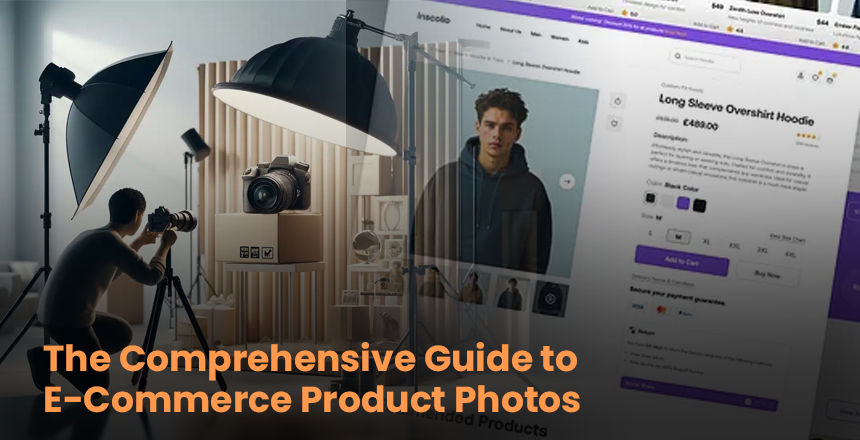When it comes to selling in the virtual environment or conventional e-commerce, visual depiction
is the essence. That is why having a professional product image is crucial for all the
companies—such an image can create or mar a sale. This is a comprehensive blog post that
Why Product Photography?
It became clear that customers, especially in the digital era, are very much a creation that pays
a lot of attention to visuals. They are more likely to buy something that has great images than
those with simple images. It is noteworthy that textured pictures can elicit an interest, contribute
to attractiveness enhancement, and help people trust the product. So, let’s learn more about
some elements that contribute to a professional product shoot for eCommerce in detail.
Planning
The idea then is to have clear goals even before you get to the studio or get out to the field. The
scope of this is from the kind of products you’re dealing with and the amount of images that
need to be taken and the type of photography you’ll be performing.
- Determine the Product: The first and foremost step in planning is to know the kind of product
you are to photograph. A lot of the time people don’t know if it is clothing, accessories, or even
more homeware. In terms of both lighting, setup, and props, all the products are unique and
need to be shot differently. - Number of Images: Determine whether each product will need one or two angles/images or
more. We need to present the product from different perspectives, such as the magnified view,
general, and real life. That is why having a certain number of images for every product is
beneficial, as it creates the consistency needed. - Style of Photography: To know which type of photography to look for, one has to understand
the category of photography. The most practiced styles are studio style, lifestyle photography, or
flat lay photography. Your selected style has to appropriate the branding and identity of your
business.
Setting up the Studio
The next thing is to establish your studio as the next step. One part of this is determining what
the lighting and backdrop will be and deciding which equipment to choose. Here’s what you
need to keep in mind:
- Lighting: One of the most important aspects of product photography has to do with lighting. This is very helpful to show the correct features of the product and the end range of the color this product is. Softboxes, umbrellas, and bare bulbs are also commonly used. Another source is the natural if you are shooting outside. The major point here is to ensure that the lighting is as equal as can be to avoid casting shadows.
- Background: The kind of backdrops to use requires a lot of consideration when it comes to
product photography. It must be dominant, yet not in a way that it overwhelms the product or
becomes more important than the product. While using interfaces, which are more formal in use,
you can choose a background that is in black, white, grey, or any other color to match your
product or even use a transparent background. - Camera: In regards to the next step as engrossing passion, it is critical to name that a good
cam is necessary for professional product photography. Get a DSLR or a mirrorless camera, as
the image settings could be well controlled, and it has a better picture quality than other options.
Lenses with big aperture numbers (low f-numbers) are appropriate when focusing sharply on
the product.
Prepping the Product
As soon as you start shooting, the product must be prepared very carefully. This entails washing
of the product, proper arrangement, and which props should be used. Here’s a step-by-step
guide:
- Cleaning: It is widely believed that a clean product looks better. Just before shooting, wipe the
product clean to clear off dust, dirt, or any smudges that may be on it. - Arrangement: Segmentation and positioning of the product is very vital. It should be placed
smack down the middle of the frame and well aligned. Make sure you’re standing very still or
using a tripod or a product turntable in order to keep things consistent. - Props: In general, by using props, the appeal of certain types of products might be improved
as a result of improvement in the look of the image. For instance, a watch will look proper on a
wooden table alongside other watches as other items of focus.
Shooting Techniques
Now that all the preparations are made, it’s time to gather some footage. Here are a few
techniques to help you get the most out of your product shoot:
- Product Turntable: The product turntable is an especially useful prop in taking 360-degree
photographs of products. It assists in establishing a smooth turn of the product so that all facets
can be demonstrated without different angles being required. - Depth of Field: This allows us to apply a low f number (most of the scene is blurry) and focus
on the product. This leads to avoiding unnecessary customization and therefore promoting the
creation of a more professional and polished look. - Angles: He did not limit himself to one particular point of view. Pan the product consistently
from the front side to the back and additionally zoom in extra close on specific details. This
leads into this, allowing customers to be able to look at it thoroughly before buying. - Strobist: This means you got to use more than one flash, and that makes the photograph a bit
better compared to a photograph done professionally. This is usually applied in studio-type
photography; its application can enhance the depth of the picture.
Post-processing
Most of the fun comes in shooting, but it doesn’t end there because it’s now time to get those
images retouched. This also
- Color Correction: Make sure that the colors in the images represent the product as realistically
as possible. Change the white balance levels and saturation in order to get the perfect picture. - Retouching: We retouch the picture; we use the internet’s tool to delete any extra things from
the picture, such as stains, dust, or anything else you do not want in a certain picture. Then crop
the product and alter the levels to try to make the product look better by increasing the
exposure, contrast, and sharpness. - Resizing: Adjust the image to the various online platforms so that the image does not take up
much space and also loads fast.
Conclusion
It’s crucial to have a professional eCommerce product shoot for any online business. A very
obvious advantage of having good signage is that you are able to give a visual representation to
your brand; the more customers you are able to entice to your business, the more sales you are
able to make. If you have your shooting strategy in place, use the appropriate accessories, and
follow professional guidelines, you are guaranteed to take beautiful product pictures that will
give your company a unique selling proposition in the current state of affairs in e-commerce.








